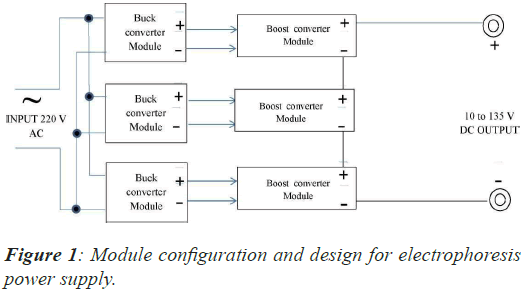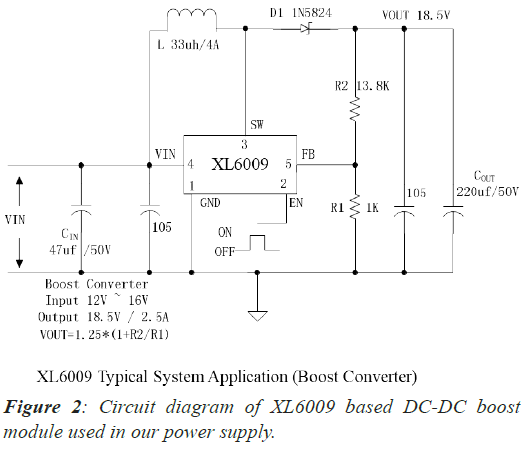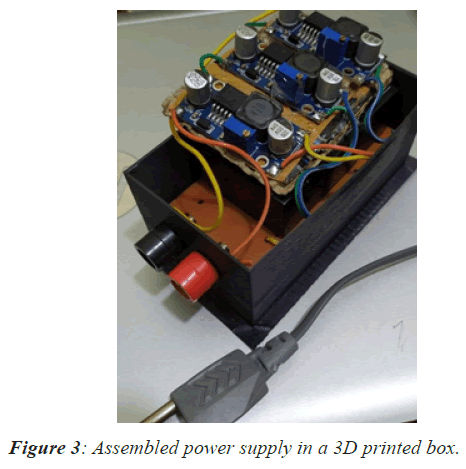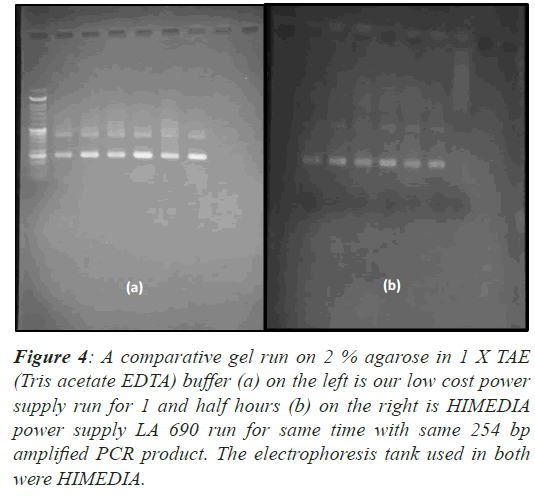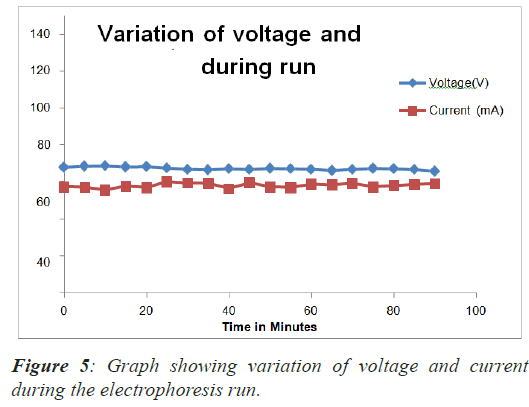Research Paper - Biomedical Research (2021) Volume 32, Issue 6
An economical power supply for DNA gel electrophoresis
Santosh Kumar1, Ravi Shekhar2*
1Senior Resident, Department of Biochemistry, Indira Gandhi Institute of Medical Sciences, Patna, India
2Additional Professor, Department of Biochemistry, Indira Gandhi Institute of Medical Sciences, Patna, India
- Corresponding Author:
- Ravi Shekhar
Additional Professor
Department of Biochemistry
Indira Gandhi Institute of Medical Sciences
Patna, India
Accepted date: October 10, 2021
Abstract
Background: Molecular biology is a growing branch of science with widespread application in life sciences. Currently, molecular biology techniques are confined to specialized fields and a large number of students are out of reach from having such education. A commonly used procedure in molecular biology is the separation of particles with the use of charge, i.e. electrophoresis. The instrument used for this procedure is complex and highly sensitive, thus expensive. As a philanthropist thought education should be free and accessible to all. So, that student in developing countries can afford to have an introductory education to vast field of molecular biology. Thus, the aim of the study was to fabricate a low cost power supply instrument for DNA agarose gel electrophoresis.
Materials and Methods: The power supply was configured using 5V SMPS module and DC-DC boost converter. Three SMPS were attached to the boost converter individually. Outputs of the all three boost converter were connected in series to obtain an output of 105V.
Result: The power supply performance was optimal for DNA agarose gel electrophoresis applications.
Conclusion: The apparatus is a low cost minimalistic design to promote DNA agarose gel electrophoresis in remote colleges and school.
Keywords
SMPS, Power Supply, DNA agarose gel electrophoresis
Introduction
Molecular Biology is a growing branch of science with widespread application in life sciences. It has application in health, livestock and food industry. Currently, molecular biology techniques are taught only in premium science institute and are confined to specialized fields. A large numbers of students are out of reach from having such education. The reason behind this is the high cost of instruments used in molecular biology techniques. Such instruments are highly sensitive and thus have huge complexity. As a philanthropist thought education should be free and accessible to all. We are trying to solve both the problem by developing instruments that can serve such purpose at a very low cost. So that students in developing countries can afford to have an introductory education to vast field of molecular biology. By encouraging molecular biology techniques and methods at secondary school level, science colleges at remote places can ignite interest among students that can disseminate novel ideas in future. Though there are a large number of instruments and technique in molecular biology, we have tried to improve one of the basic techniques of gel electrophoresis. Electrophoresis is widely used for detection using a stabilizing power supply consisting a complicated circuit [1]. DNA gel electrophoresis requires a gel running apparatus and a power supply. The power supply part is very expensive as it is design for a wide range of voltage and current.
Just a few decades ago, the standardization of the apparatus for diagnostic purpose and densitometric reading of the run was a cumbersome process. Now software’s are available which are able to differentiate bands efficiently. Thus, requiring small run and less time. Our power pack design focused on a narrow range low current design that is sufficient for running gels and DNA fragments.
Materials and Methods
The design of power supply features constant voltage and current mode to make the setting less complex. Also the pre calculated max voltage and current required for this purpose is around 100 V and 100 mA [2,3]. This is determined on the basis of a 10 cm × 10 cm agarose gel (0.5 to 8%) with thickness of 5 mm [4]. Most of the DNA electrophoresis and PCR product electrophoresis can be done easily in this range [5,6].
Design
The power supply is built around cheapest isolated SMPS power module (easy power mountable power supply) available in the market [7]. The input source is 220V AC which is step down to 5 V @1A DC designed for mobile charger. Input and output are totally isolated hence no major harm will occur. Three such module will power DC-DC boost converter based on XL 6009 one for each [8]. The output of each boost converter is set to 35V DC and each can deliver current approximately upto 200 mA. All three modules are joined in series to get a output of 105 V DC (Figures 1 and 2). This output is connected to banana socket that is compatible with electrophoresis tank size upto 22 cm × 15 cm.
A comparative gel run on 2% agarose in 1 × TAE (Tris acetate EDTA) buffer (a) on the left is our low cost power supply run for 90 minutes (b) on the right is HIMEDIA power supply LA 690 run for 90 minutes with same 254 bp amplified PCR product. The electrophoresis tanks used in both were HIMEDIA electrophoresis tank (LA 666).
Discussion
The current design is open source and can be assembled easily at low cost. Each module is completely isolated from the mains, so risk of major mishap is minimum. Power dissipation of each module is very low as it operates at low current and low voltage. Each step down module dissipates 2.5 W. So, total maximum power dissipation for 3 modules is just 7.5 W. It was found that 3.5 W was consumed. A current limiting circuit and a variable knob could have been added for extra functionality, but that would have increased the cost. Xl 6009 regulator takes care of constant voltage which was sufficient for our purpose [9-11]. The designed power supply can be built by any person who can solder wires and make connection. The purpose of using a module based design was to reduce cost and complexity. This power supply can be assembled under ₹ 500. If parts are procured at wholesale rate then its assembly can bring the cost down to ₹ 300. One can also fabricate all the circuit on a single PCB but that would be more costly than to use already used modules available in the market. Whole assembly can be housed inside a 15 cm x 15 cm x 5 cm box (wood, PVC,etc (Figure 3). The foot-print of power supply was managed efficiently by the use of 3D printed PLA box. Short circuit protection and adjustability of voltage and current are also incorporated in the modules, so it is much safer than high voltage power supply due to low current output. The power supply is best suitable for gene polymorphism, cloning, DNA analysis etc.
In 2 % agarose gel with 254 bp PCR product was run for 90 minutes with our power supply and the same was compared with a branded power supply (HIMEDIA LA 690). The tank used in both the setup was HIMEDIA electrophoresis tank (LA 666) .We found PCR product band migrated to 6 cm in both setup with little difference (Figure 4). Thus, our low cost power supply performed exactly similar to that of branded one. The voltage and current variation during the run was almost constant (Figures 5). The dynamic change in resistance is always a factor to have either constant voltage or constant current power supply. Xl 6009 DC modules are constant voltage sources and the output current is allowed to varied (Table 1). Even when current varies, due to low heat generation there is very little variation in resistance that causes insignificant change in current. Few authors have published design based on voltage multiplier circuit, but with no isolation with AC input [12,13].
Figure 4: A comparative gel run on 2 % agarose in 1 X TAE (Tris acetate EDTA) buffer (a) on the left is our low cost power supply run for 1 and half hours (b) on the right is HIMEDIA power supply LA 690 run for same time with same 254 bp amplified PCR product. The electrophoresis tank used in both were HIMEDIA.
| Time (Min) | Voltage(V) | Current (mA) |
|---|---|---|
| 0 | 67.8 | 57.3 |
| 5 | 68.4 | 56.9 |
| 10 | 68.6 | 55.4 |
| 15 | 68 | 57.6 |
| 20 | 68.2 | 56.8 |
| 25 | 67.5 | 60.1 |
| 30 | 66.7 | 59.3 |
| 35 | 66.4 | 59.2 |
| 40 | 67 | 56.1 |
| 45 | 66.6 | |
| 50 | 67.2 | 57.2 |
| 55 | 67 | 56.8 |
| 60 | 66.7 | 58.6 |
| 65 | 66 | 58.2 |
| 70 | 66.6 | 59.1 |
| 75 | 67.2 | 57.2 |
| 80 | 67 | 57.8 |
| 85 | 66.5 | 58.5 |
| 90 | 65.6 | 58.9 |
Table 1. Voltage and current variation during run.
Disadvantage of this type of design is the inability to use it for protein electrophoresis requiring upto 500 V@400 mA, as that can be easily done with same power supply or available in market [1]. But, it is to be clearly stated that the current design is only for running DNA on agarose gel of 10 cm x 10 cm x 5 mm which can be achieved easily with 80-90 V at 70-100 mA. So, the need for redundancy of variable high voltage has to be sacrificed in power pack.
Conclusion
A low cost power supply can be bought by student with very poor resources which in turn will help in accessing education of expensive field of molecular biology at a very cheap price.
References
- Kadokami Y, Takao K, Saigo K. An economic “power supply” using a diode for agarose and polyacrylamide gel electrophoresis. Anal Biochem 1984; 137: 156-160.
- Wheeler D. The Role of the Voltage Gradient in the Agarose Gel Electrophoresis of DNA. 1990.
- Kirkpatrick FH. Overview of agarose gel properties. Electrophoresis of large DNA molecules: theory and applications 1991; 9-22.
- Serwer P. Agarose gels: properties and use for electrophoresis. Electrophoresis 1983; 4: 375-382.
- Lee PY, Costumbrado J, Hsu CY, Kim YH. Agarose gel electrophoresis for the separation of DNA fragments. J Vis Exp 2012; 62: e3923.
- Li Z, Huang J, Yang B, You Q, Sekine S, Zhang D. Miniaturized Gel electrophoresis system for fast separation of nucleic acids. Sensors and Actuators B: Chemical 2018; 254: 153-158.
- SO5V500, Easy power mountable SMPS. Datasheet Assessed on 2020.
- XLSEMI. 400KHz 42V 5A Switching Current Boost DC/DC Converter. XL6009 datasheet. Assessed on 2020.
- Kannan R, Samad NIA, Romlie MF, Nor NM, Kumar LA. Design and execution of single input multiple output DC-DC converter. (ICSIPA) 2017; 164-169.
- Ki WH, Ma D. Single-inductor multiple-output switching converters in Power Electronics Specialists Conference. 2001.
- Prieto MBF, Litran SP, Aranda ED, Gomez JME. New single-input, multiple-output converter topologies: Combining singleswitch nonisolated dc-dc converters for single-input, multiple-output applications. IEEE Industrial Electronics Magazine 2016; 10: 6-20.
- Ogochukwu, Ezeonu, Okonkwo, Godfrey. Construction and testing of electrophoresis power supply. 2011; 7: 457-460.
- Walker JH. Polyacrylamide gel electrophoresis using a 12 volt Battery Charger as a power pack. High Resolution Microgels on a low budget. Biomedical Education 1988; 16: 43-44.
